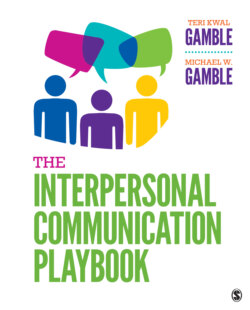Читать книгу The Interpersonal Communication Playbook - Teri Kwal Gamble - Страница 127
На сайте Литреса книга снята с продажи.
Unconscious Bias, Ethnocentrism, and Stereotypes
ОглавлениеUnconscious bias is a bias we are unaware that we harbor. Unknowingly, we take mental shortcuts derived from social norms and stereotypes. Ethnocentrism is the tendency to perceive right and wrong according to the categories and values of one’s own culture. When we are ethnocentric, we formulate categorizations that are familiar and comfortable to our “in-group” and apply categorizations that are unfamiliar and awkward to an “out-group.” Unconscious biases together with more overt feelings of ethnocentrism can lead us to rely on stereotypes that reduce our communication effectiveness.
Stereotypes are widely held but oversimplified preconceived generalizations applied to all members of a group regardless of individual variations.36 Once generalizations become rigid stereotypes, they contribute to our losing touch with the real world. Such stereotypes share two key characteristics: (1) They lead us to categorize others on the basis of easily recognized, but not necessarily significant, qualities (for example, a person’s ethnicity), and (2) they lead us to ascribe an array of qualities to most or all members of a group (for example, assuming that all people of Asian descent are soft-spoken). When our generalizations harden, we are likely to disregard any differences in individuals that set them apart from the stereotyped group.
Stereotyping and racial profiling, a specific kind of stereotyping, have the potential to plague both interracial and intercultural communication. When we stereotype instead of responding to the communication or cues of individuals, we create expectations, assume those expectations are valid, and behave as if they have already occurred. We judge people on the basis of what we believe regarding the group in which we have placed them. We emphasize similarities and overlook differences. Stereotyping leads us to oversimplify, generalize, and grossly exaggerate our observations.
Sometimes we find ourselves in situations requiring a decision based on little information other than appearance. Unfortunately, in addition to making clothing-trait associations, we also are prone to making “feature-trait associations,” relying on physical appearance to make judgments regarding the categories people belong to and the traits they possess. While we may believe we are responding to a specific person, what we are really acting on is a stereotype. For example, certain physical features—dark skin, coarse hair, full lips, and a wide nose—signal to some people that a person is African American. This is a stereotype that produces a stereotypic judgment. And the more “Afrocentric” an individual’s features, the more he or she is ascribed traits stereotypical of African Americans.37 Colorism researchers report that more prejudice and discrimination are directed against dark-skinned African Americans than against light-skinned African Americans; the latter are more likely to have better jobs and to attain higher levels of education than those with darker skin.38 Researchers note that although we may see more African American lawyers and doctors in prime-time television offerings, those characters tend to be lighter skinned. Unconscious bias, ethnocentrism, stereotyping, and lack of diversity are connected.
Lazy perceivers rely on stereotyping as their key perceptual process. Because it discourages careful observation and encourages pigeonholing and categorization, some have observed that stereotyping brings on a malady called “hardening of the categories,” in which we insist on fitting everyone into a niche. When we do this, we fail to recognize that every person is unique in some way and in fact constitutes his or her own category.
The marriage of African American Meghan Markle to Prince Harry shattered stereotypes.
Karwai Tang/WireImage/Getty Images
Together, schemata, sets, unconscious bias, ethnocentrism, and stereotypes play major parts in structuring our social perceptions. By recognizing their roles and understanding their potential effects, we can prepare ourselves to question whether we are processing experience accurately and are thinking critically and reflectively about our judgments.
